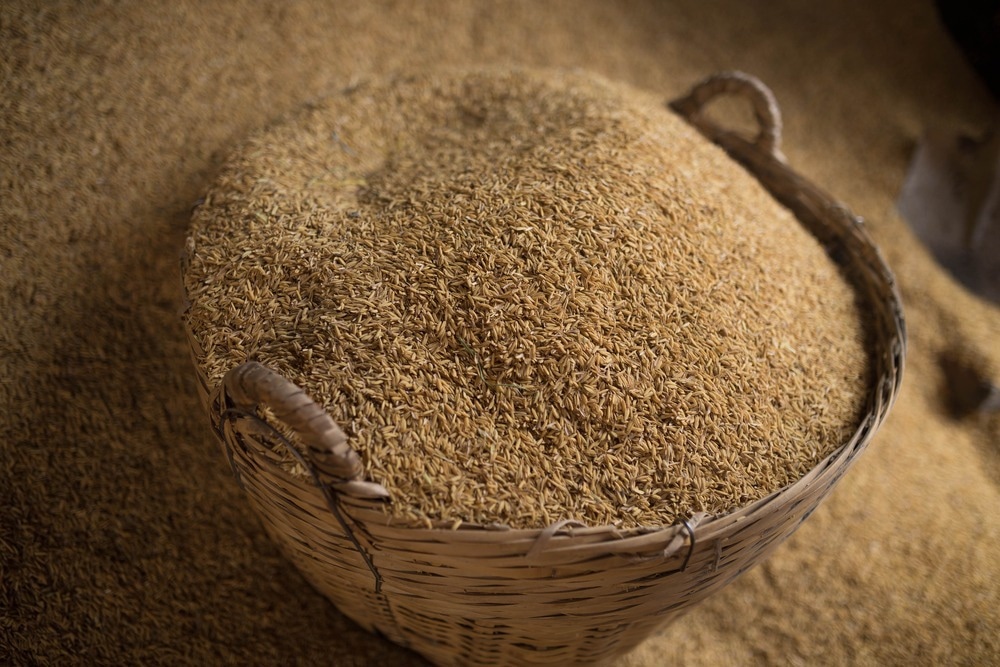Scientists from four universities in China have collaborated on a new paper in the journal Science of the Total Environment investigating how rice husks can improve magnesium oxychloride cement, a green building material.

Study: Mechanical, water resistance and environmental benefits of magnesium oxychloride cement incorporating rice husk ash. Image Credit: stovere/Shutterstock.com
Improving the Eco-friendliness of Cement Production
The construction industry faces urgent challenges in the 21st century with meeting its net zero carbon targets. A substantial proportion of the industry’s carbon emissions are caused by the manufacture and use of cement and concrete, with cement production (commonly, ordinary Portland cement) accounting for around 8% of total global anthropogenic greenhouse gas emissions.
To overcome this key issue, scientists in recent years have focused on the manufacture and application of environmentally friendly alternatives to partially replace or phase out the use of this ecologically damaging building material.
Aside from concerns about the carbon emitted by cement manufacturing, there is a growing awareness of the impact of industrial waste disposal and the loss of valuable resources which could otherwise be used to produce new products.
Incorporating industrial and agricultural wastes into cement as aggregates and fillers is a key area of research currently. Common industrial wastes which have been considered include solid industrial waste such as metallurgical slag, construction waste such as waste glass and recycled aggregates, and agricultural waste such as straw and rice husk. Efficient waste reuse reduces pressure on landfills and the environment.
Magnesium Oxychloride Cement
Amongst the sustainable cement types considered in the construction industry, magnesium oxychloride cement has drawn the attention of researchers. This green building material incorporates light-burned magnesia and magnesium chloride.
Magnesium oxychloride cement is advantageous for sustainable construction due to lower carbon emissions thanks to reduced energy consumption during the manufacture of light-burned magnesia. The calcination temperature of magnesite is around 500 oC lower than that of ordinary Portland cement.
Magnesium oxychloride cement has been applied in building materials, thermal insulation, and packaging due to its superior mechanical properties such as compressive strength and bonding strength, low thermal conductivity, and excellent fire-resistant properties.
Despite these benefits, there is still a key challenge with this sustainable material that limits its commercial viability: its poor water resistance. In humid environments, unreacted light-blasted magnesia can be converted to Mg(OH)2, and the product can dissolve.
Several strategies have been evaluated to overcome this key issue with the material. Researchers have explored the use of organic acids, soluble phosphates, inert fillers, and active SCMs to modify magnesium oxychloride cement. One study has investigated the benefits of incorporating waste gypsum, which enhances the material’s water resistance but significantly reduces its mechanical properties.
Several different construction, industrial, and agricultural wastes have been explored in recent years, which possess the benefits of improving water resistance and mechanical properties. Moreover, these strategies are more environmentally friendly than organic acids and additives.
The Study
The new paper in Science of the Total Environment specifically focuses on the benefits of using rice husk ash, a key agricultural waste stream, to improve the environmental friendliness, water resistance, and mechanical properties of magnesium oxychloride cement. The influence of this waste material on the cement’s microstructure was analyzed in the paper.
It has been noted by the authors that previous work conducted on the incorporation of rice husk ash into magnesium oxychloride cement investigated improvement effects on the interface between matrix and fiber and the material’s toughness. Water resistance effects were ignored.
The authors conducted a comprehensive microstructural investigation of rice husk-modified cement. Analysis included phase identification using XRD, phase content using TG-DSC, and morphology-elemental analysis using SEM-EDS. Furthermore, the environmental benefits of this material were evaluated in the study. The performance of the modified cement was compared to conventional modification methods.
Study Conclusions
The authors drew several conclusions based on the analysis of rice husk-modified magnesium oxychloride cement. Modifying this sustainable building material with rice husk ash has several benefits.
Setting time and flowability were improved by the modification at optimal concentrations. Additionally, the incorporation of appropriate rice husk ash content improves mechanical properties underwater and air curing. Compactness is improved by the rice husk ash’s filling effect. Strength is improved by this effect and the formation of a gel due to interactions between husk ash and cement.
Water resistance is improved by lower water absorption and slower cement-water reaction caused by the dense material matrix. Furthermore, an amorphous Mg-Cl-Si-H gel is generated, improving compactness and water resistance.
Environmental benefits were observed as well, along with performance gains. Increased rice husk ash content decreases the carbon emissions during manufacture. This is a highly efficient, environmentally friendly, and value-added approach to manufacturing sustainable cement for multiple industries.
Further improvements could be made by studying strategies to enhance traditional SCMs, inorganic salts, and organic modifiers, with opportunities to enhance the water resistance of magnesium oxychloride cements. Overall, the use of rice husk ash to modify green cements provides a route toward truly sustainable building materials with enhanced water resistance, which could replace ordinary Portland cement in construction.
More from AZoM: How Can Polymer Strips Be Used to Clean Up Oil Spills?
Further Reading
Nie, Y., et al. (2022) Mechanical, water resistance and environmental benefits of magnesium oxychloride cement incorporating rice husk ash Science of the Total Environment 157871 [online, pre-proof] sciencedirect.com. Available at: https://www.sciencedirect.com/science/article/abs/pii/S0048969722049701
Disclaimer: The views expressed here are those of the author expressed in their private capacity and do not necessarily represent the views of AZoM.com Limited T/A AZoNetwork the owner and operator of this website. This disclaimer forms part of the Terms and conditions of use of this website.